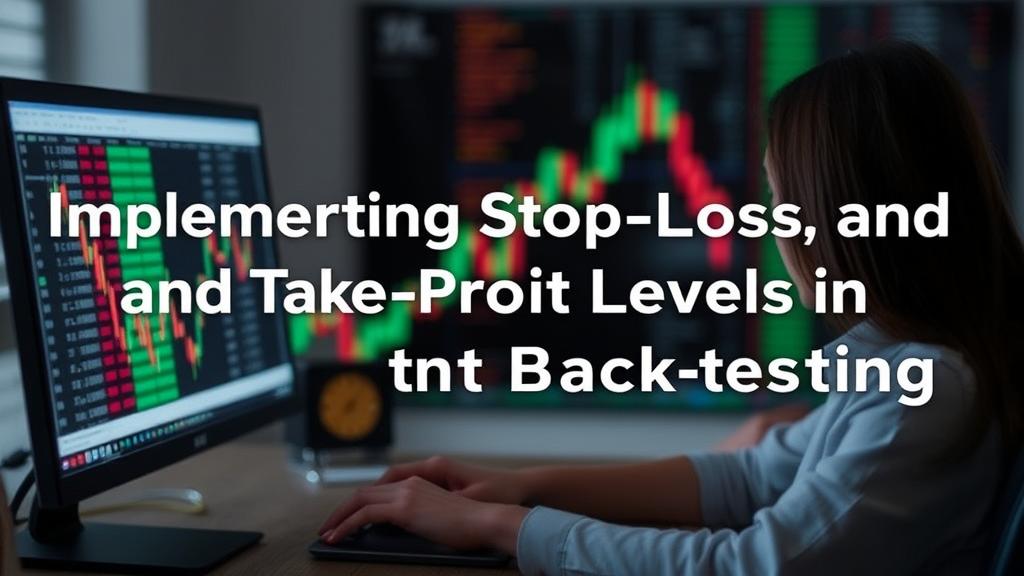Inviting Exploration of Advanced Strategies
Curious about how advanced algorithms are influencing investment strategies? Let’s dive into the mechanics of modern trading.
Before diving into the intricacies of backtesting these levels, it’s essential to grasp why they are critical components of any trading strategy.
The Role of Stop-Loss Levels
Stop-loss orders are designed to limit an investor’s loss on a position. By setting a predetermined price at which a security will be sold, traders can avoid emotional decision-making during volatile market conditions.
- Protection Against Large Losses:** They prevent significant downswings in your portfolio.
- Emotional Discipline:** Automating exit points removes the psychological burden of decision-making during trades.
- Risk Management:** Traders can define risk levels for each trade, making it easier to manage overall exposure.
The Role of Take-Profit Levels
Take-profit orders allow traders to secure profits when a security reaches a specific price point. This strategy is essential in volatile markets where price fluctuations can quickly turn profits into losses.
- Securing Gains:** They ensure that profits are realized before market reversals can occur.
- Simplifying Strategy:** Traders can set clear targets, making it easier to execute their plans consistently.
- Encouraging Discipline:** Like stop-loss orders, take-profit levels help maintain discipline by automating the exit process.
The Basics of Backtesting
Backtesting refers to the process of testing a trading strategy using historical data to evaluate its potential effectiveness. This analysis helps traders understand how different strategies would have performed in various market conditions.
Key Steps in Backtesting
- **Define Your Strategy:** Clearly outline your trading strategy, including entry and exit points, risk management parameters, and position sizing.
- **Collect Historical Data:** Gather relevant historical price data for the asset you intend to trade. This data should include open, high, low, and close prices.
- **Simulate Trades:** Apply your strategy to the historical data, simulating trades based on your defined entry and exit criteria.
- **Analyze Results:** Evaluate the performance of your strategy, focusing on metrics such as win rate, average profit/loss, maximum drawdown, and total return.
- **Refine Your Strategy:** Make adjustments as needed based on your analysis to optimize performance.
Implementing Stop-Loss and Take-Profit Levels in Backtesting
Now that we have a foundational understanding of stop-loss and take-profit levels, as well as backtesting, let’s explore how to effectively implement these concepts within your backtesting framework.
Setting Stop-Loss and Take-Profit Levels
When incorporating stop-loss and take-profit levels into your backtesting, consider the following approaches:
- **Percentage-Based Levels:**
- Set stop-loss and take-profit levels as a percentage of the entry price. For example, you might set a stop-loss at 2% below the entry price and a take-profit level at 5% above.
- **Volatility-Based Levels:**
- Adjust stop-loss and take-profit levels based on the asset’s volatility. Tools like the Average True Range (ATR) can help you determine optimal distance from the entry price.
- **Technical Indicators:**
- Utilize technical indicators such as support and resistance levels or moving averages to establish logical exit points.
- **Trailing Stop-Loss:**
- Implement a trailing stop-loss that moves with the market price, allowing for potential gains while still protecting against reversals.
Example of Implementing Levels in Backtesting
Consider a simple trading strategy that involves entering long positions when a stock’s 50-day moving average crosses above its 200-day moving average:
- **Entry Point:**
- Buy when the 50-day MA crosses the 200-day MA.
- **Stop-Loss Level:**
- Set a stop-loss at 3% below the entry price.
- **Take-Profit Level:**
- Set a take-profit at 6% above the entry price.
- **Backtesting Results:**
- Analyze how many trades hit the stop-loss versus the take-profit. Calculate the overall profitability and drawdowns during the testing period.
Best Practices for Backtesting with Stop-Loss and Take-Profit Levels
To maximize the effectiveness of your backtesting process, consider these best practices:
- **Use Sufficient Historical Data:**
- Ensure your historical data covers multiple market conditions (bull, bear, and sideways). A robust dataset enhances the reliability of your results.
- **Avoid Overfitting:**
- While adjusting parameters to improve backtest results, avoid making changes solely to fit past data. This practice can lead to strategies that perform poorly in real-time trading.
- **Incorporate Slippage and Commissions:**
- Account for transaction costs, slippage, and market impact in your backtesting model. These factors can significantly affect actual trading performance.
- **Run Multiple Scenarios:**
- Test various stop-loss and take-profit scenarios. For instance, assess the performance of tighter versus looser levels to determine optimal settings.
- **Review and Adapt:**
- Continuously review your strategy’s performance and adapt as necessary. Markets evolve, and so should your approach.
Conclusion
Implementing stop-loss and take-profit levels in backtesting is crucial for developing a robust trading strategy. By clearly defining your strategy, collecting historical data, and simulating trades with well-thought-out exit points, you can gain valuable insights into your trading performance.
Adhering to best practices will not only improve your backtesting results but also enhance your trading discipline and risk management. As with any skill, practice and refinement are key—continuously assess and adapt your approach, and you’ll be well on your way to achieving consistent trading success. Whether you are a novice trader or a seasoned professional, mastering the art of backtesting with effective stop-loss and take-profit strategies will undoubtedly elevate your trading game.



